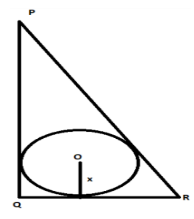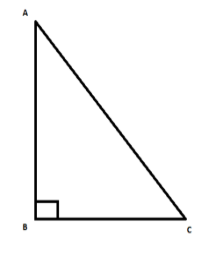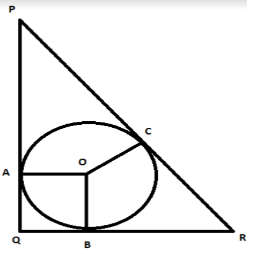Question
Question: In \(\Delta PQR,PQ=24\)cm, \(QR=7\)cm and \(\angle PQR={{90}^{\circ }}\). Find the radius (in cm) of...
In ΔPQR,PQ=24cm, QR=7cm and ∠PQR=90∘. Find the radius (in cm) of the inscribed circle.

Solution
Hint: If two tangents are drawn from a point to a circle, then the length of those two tangents from that particular point to the circle will be equal. In this question, PQ,QR and PR are the tangents to the circle.
In this question, we are given a right angle triangle having sides PQ=24cm, QR=7cm and ∠PQR=90∘. We can calculate the length of side PR by using Pythagoras theorem.
Consider a triangle ABC having ∠ABC=90∘.

Using Pythagoras theorem the relation between the base, perpendicular and the hypotenuse of the
triangle is given by,
AC=(AB)2+(BC)2.....................(1)
Using Pythagoras theorem from equation (1) in the triangle PQR, we get,
PR=(PQ)2+(QR)2
In the question, it is given PQ=24cm, QR=7cm.
⇒PR=(24)2+(7)2⇒PR=576+49⇒PR=625⇒PR=25
Since the circle is inscribed in the triangle PQR, sides PQ,QR,PR will act as a tangent to the
circle. Let us name the point of contact of circle with the tangent PQ as A, tangent QR as B
and tangent PR as C. Let us join the point A,B,C to the center of the circle O . Also, let us
consider the radius of the circle equal to x.

Since OA,OB,OC are the radius, their lengths are equal to x.
It can be seen from the figure that in quadrilateral AOQB, two adjacent sides (OA,OB) are equal
(since they are the radius of the circle) and all the angles are right angles. This means, AOQB is a
square. So, AQ=x and BQ=x.
There is a property of tangent which states that, if two tangents are drawn from a point to a circle,
then the length of those two tangents from that particular point to the circle will be equal. Using this
property in the above triangle,
⇒PA=PC,QA=QB,RB=RC............(2)
We have obtained AQ=x. Also PQ=24. Since PAQ is a straight line, we can say,
PA=PQ−QA⇒PA=24−x
From (2), we have PA=PC.
⇒PC=24−x............(3)
Also, we have obtained BQ=x. Also QR=7. Since QBR is a straight line, we can say,
RB=QR−QB⇒RB=7−x
From (2), we have RB=RC.
⇒RC=7−x............(4)
Since PCR is a straight line, we can write,
PR=PC+RC
Using Pythagoras theorem, we obtained PR=25cm. Also, from equation (1) and
equation (2), we have PC=24−x and RC=7−x. Substituting in the above equation,
we get,
25=24−x+7−x⇒2x=6⇒x=3
Hence, the radius of the inscribed circle is 3.
Note: There is an alternative method to find the radius of the inscribed circle. The radius of the
inscribed circle of a triangle is given by the formula, r=sK where K is the area of the
triangle and s is the half of the perimeter of the triangle.
